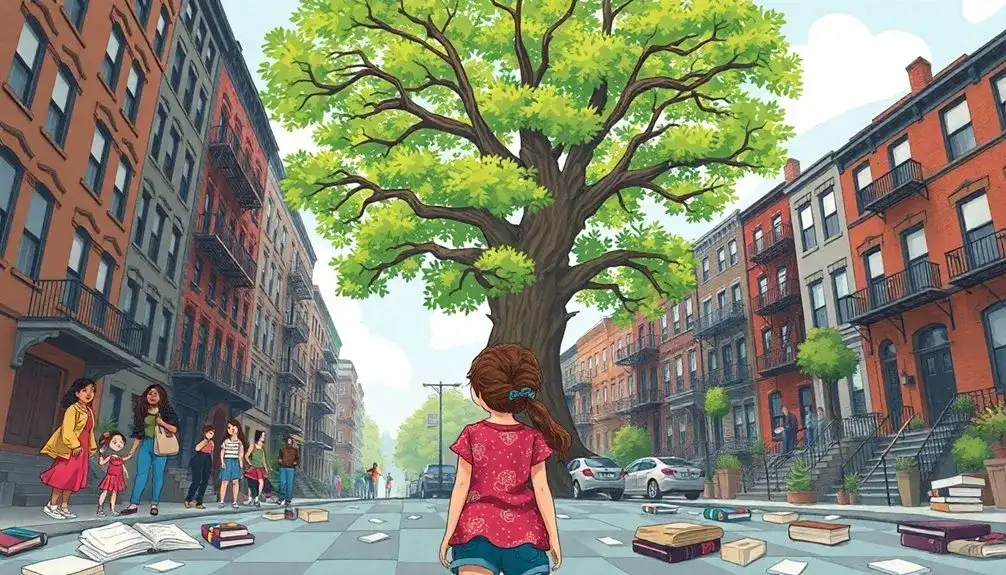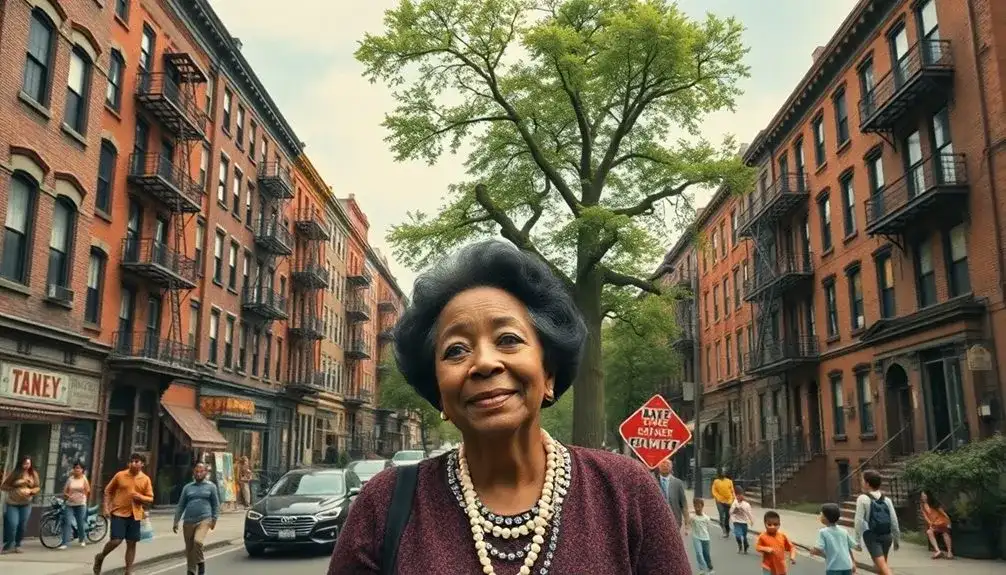Introduction
Betty Smith’s A Tree Grows in Brooklyn, first published in 1943, has long stood as one of the most cherished novels in American literature. With its heartfelt portrayal of a young girl’s struggle to overcome the burdens of poverty, societal expectations, and familial hardship, the novel resonates with generations of readers. Set in the early 20th-century neighborhood of Williamsburg, Brooklyn, it follows Francie Nolan, a bright and imaginative girl whose ambition and resilience fuel her dream of a better life. At its heart, the novel is a coming-of-age story rooted in a richly detailed historical and cultural context, exploring the themes of poverty, resilience, education, and the immigrant experience.
This exploration will offer an in-depth analysis of A Tree Grows in Brooklyn, from its characters and themes to its symbolism and social impact. It will also delve into the life of Betty Smith and the novel’s continued relevance in modern times.
I. Overview of the Novel

A Tree Grows in Brooklyn is more than just a story about growing up; it is an intricate tapestry that weaves together the struggles of working-class immigrants in early 20th-century New York. Through Francie Nolan’s eyes, readers are introduced to the harsh realities of tenement life, the complexities of family dynamics, and the quiet strength found in perseverance.
Set in Williamsburg, Brooklyn, during the 1910s and 1920s, the novel centers on the Nolan family: Francie, her hardworking mother Katie, her charismatic yet unreliable father Johnny, and her younger brother Neeley. The story unfolds in a linear and reflective manner, chronicling Francie’s childhood and adolescence as she faces poverty, prejudice, and personal loss. Central to the novel is the idea that even in the harshest environments, hope can flourish—symbolized by the persistent Tree of Heaven that grows outside the Nolans’ window.
Betty Smith brings to life a world filled with immigrant voices and experiences, making the story feel both intimate and universally relatable. Themes such as ambition, self-sacrifice, and the power of education resonate throughout the narrative, serving as a beacon for those who seek to rise above their circumstances.
II. Main Characters and Character Development
Francie Nolan
Francie is the beating heart of the novel. Intelligent, sensitive, and imaginative, she represents the struggle of many young girls striving for a better life in an unforgiving world. Much like Liesel in Markus Zusak’s The Book Thief, Francie turns to books and writing as a refuge and a means of empowerment. Her love for storytelling becomes both a coping mechanism and a tool for transformation.
Francie’s determination to succeed academically, despite the odds stacked against her, showcases her unwavering ambition. Her growth from a wide-eyed child to a determined young woman is central to the novel’s emotional journey.
Katie Nolan
Katie, Francie’s mother, is a pillar of strength and endurance. She represents the sacrifices mothers often make for the well-being of their families. Though often perceived as emotionally distant, Katie’s unwavering commitment to her children’s future makes her one of the novel’s most admirable characters.
Johnny Nolan
Francie’s father, Johnny, is both charming and tragic. His love for his family is genuine, but his struggle with alcoholism and inability to hold down a job render him an unreliable provider. Johnny’s character adds depth to the narrative, highlighting the complexities of love, failure, and lost potential.
Neeley Nolan
Neeley, Francie’s younger brother, offers a contrasting response to their shared hardships. While he does not share Francie’s academic ambitions, his close bond with Francie adds warmth to the narrative and provides a broader perspective on how different individuals cope with adversity.
III. Major Themes

1. Poverty and Resilience
Poverty permeates every aspect of the Nolan family’s life, from their modest meals to their worn clothing and cramped living conditions. Yet, instead of succumbing to despair, the Nolans find small ways to assert control over their lives. Katie saves coffee grounds to make a daily cup of coffee, a symbol of dignity and routine. Francie finds solace in books borrowed from the library.
The Tree of Heaven, growing despite the cement that surrounds it, is a potent symbol of this resilience. Like the tree, Francie pushes through the cracks of hardship, determined to find the sunlight of opportunity.
2. Education and Ambition
Francie views education as her ticket out of poverty. Her fierce desire to learn is encouraged by her grandmother Mary Rommely, who emphasizes the importance of reading a page from the Bible and Shakespeare daily. This creates a culture of literacy within the household.
Francie excels academically, despite being sent to subpar schools, and later earns the opportunity to attend a better school under false pretenses. Her journey underscores the barriers faced by poor, working-class children—especially girls—in accessing quality education.
3. The Immigrant Experience
Betty Smith captures the diversity of Brooklyn’s immigrant communities, including Irish, German, Italian, and Jewish families. Through the Nolans’ interactions with their neighbors and society at large, readers witness the cultural tensions, class struggles, and prejudices faced by immigrants trying to integrate into American life.
This theme intersects with identity, as Francie tries to reconcile her Irish-American heritage with her aspirations to succeed in a society that often marginalizes people like her.
4. Family Dynamics and Sacrifice
Family is both a source of support and a site of conflict in the novel. Katie and Johnny’s marriage is fraught with tension, yet they remain committed to their children. Katie’s favoritism toward Neeley and her emotional distance from Francie create emotional wounds, but also fuel Francie’s drive for independence.
The extended family, including Aunt Sissy and Mary Rommely, adds dimension to the story. Aunt Sissy’s scandalous love life and Mary Rommely’s old-world wisdom enrich the narrative with humor and depth.
IV. Symbolism and Motifs
The Tree of Heaven
The most enduring symbol in the novel, the Tree of Heaven, grows in unlikely places and survives even when cut down. It represents hope, survival, and the strength to grow in adversity. It mirrors Francie’s own journey and stands as a testament to the human spirit.
Books and Literacy
Francie’s love of books serves as a recurring motif. Libraries and schools are sanctuaries, offering escape and enlightenment. Her growing skill as a writer symbolizes her emerging identity and personal growth.
Coffee
Coffee, particularly Katie’s ritual of making one cup each morning, represents a form of control and dignity amid chaos. It symbolizes small comforts and the importance of routine in difficult circumstances.
Hunger
Both physical and emotional hunger are explored in the novel. The family’s financial struggle leads to literal hunger, while Francie experiences emotional hunger for love, acceptance, and opportunity. This motif deepens the emotional landscape of the novel.
V. Historical and Cultural Context

Early 20th-Century Brooklyn
The novel’s setting is as much a character as any person in the book. Early 1900s Brooklyn was a melting pot of immigrant cultures and industrial growth. Tenement housing, factory labor, and public schools shaped the lives of millions.
Smith’s detailed depiction of street vendors, factory work, and community rituals paints a vivid picture of life during this period, revealing both the vibrancy and the hardship of immigrant communities.
Immigration and the American Dream
The pursuit of the American Dream underpins much of the novel. For the Nolans and their peers, America represents a land of opportunity, yet systemic barriers often keep them on the margins. The novel questions whether hard work alone is enough to escape poverty.
Social and Gender Roles
The novel critiques the limitations placed on women and the working class. Katie’s role as the family’s breadwinner challenges traditional gender roles, while Francie’s ambition defies societal expectations of femininity. The tension between domestic duty and personal aspiration is a recurring theme.
VI. Betty Smith: Authorial Insight
Betty Smith was born Sophina Elisabeth Wehner in 1896 to German immigrant parents. Her upbringing in Brooklyn provided the foundation for A Tree Grows in Brooklyn. She drew upon her own experiences of poverty, resilience, and a deep love for literature.
Smith’s literary career began after winning the Hopwood Award at the University of Michigan. Though she worked in various fields, including as a journalist and playwright, her true breakthrough came with her debut novel.
Smith continued to write, producing several other novels, but none achieved the acclaim of her first. Her commitment to portraying working-class women and immigrant families with dignity and complexity remains her greatest legacy.
VII. Critical Reception and Cultural Impact
Upon its release in 1943, A Tree Grows in Brooklyn was a commercial and critical success. It sold over 4 million copies and was adapted into a successful film in 1945. Though initially dismissed by some critics as overly sentimental, the novel’s emotional honesty and richly drawn characters won over readers.
The novel has remained a staple of American literature curricula, celebrated for its relatable themes and historical significance. Influential figures, including Oprah Winfrey, have cited the book as a formative influence.
Its relevance endures because it speaks to universal experiences: growing up, facing hardship, and striving for something more. The novel encourages empathy and offers a nuanced view of poverty, ambition, and family life.
VIII. Cultural Significance and Legacy
A Tree Grows in Brooklyn occupies a vital place in American cultural consciousness. It provides a window into a specific time and place while also telling a story that transcends generations.
Its exploration of systemic issues such as class inequality, gender roles, and education makes it a valuable text for understanding social dynamics, both past and present. Its legacy is evident in how frequently it is referenced, adapted, and taught.
Smith’s novel paved the way for future writers to explore the lives of working-class women and immigrants with empathy and realism. It continues to inspire discussions on resilience, identity, and the power of storytelling.
Conclusion
A Tree Grows in Brooklyn is not just a novel about a girl in Brooklyn; it is a powerful narrative about the enduring human spirit. Through Francie Nolan’s eyes, Betty Smith invites readers to reflect on their own experiences with hardship, ambition, and hope. The novel remains a testament to the belief that beauty can grow in even the most unlikely places, making it a timeless classic that continues to resonate across cultures and generations.



